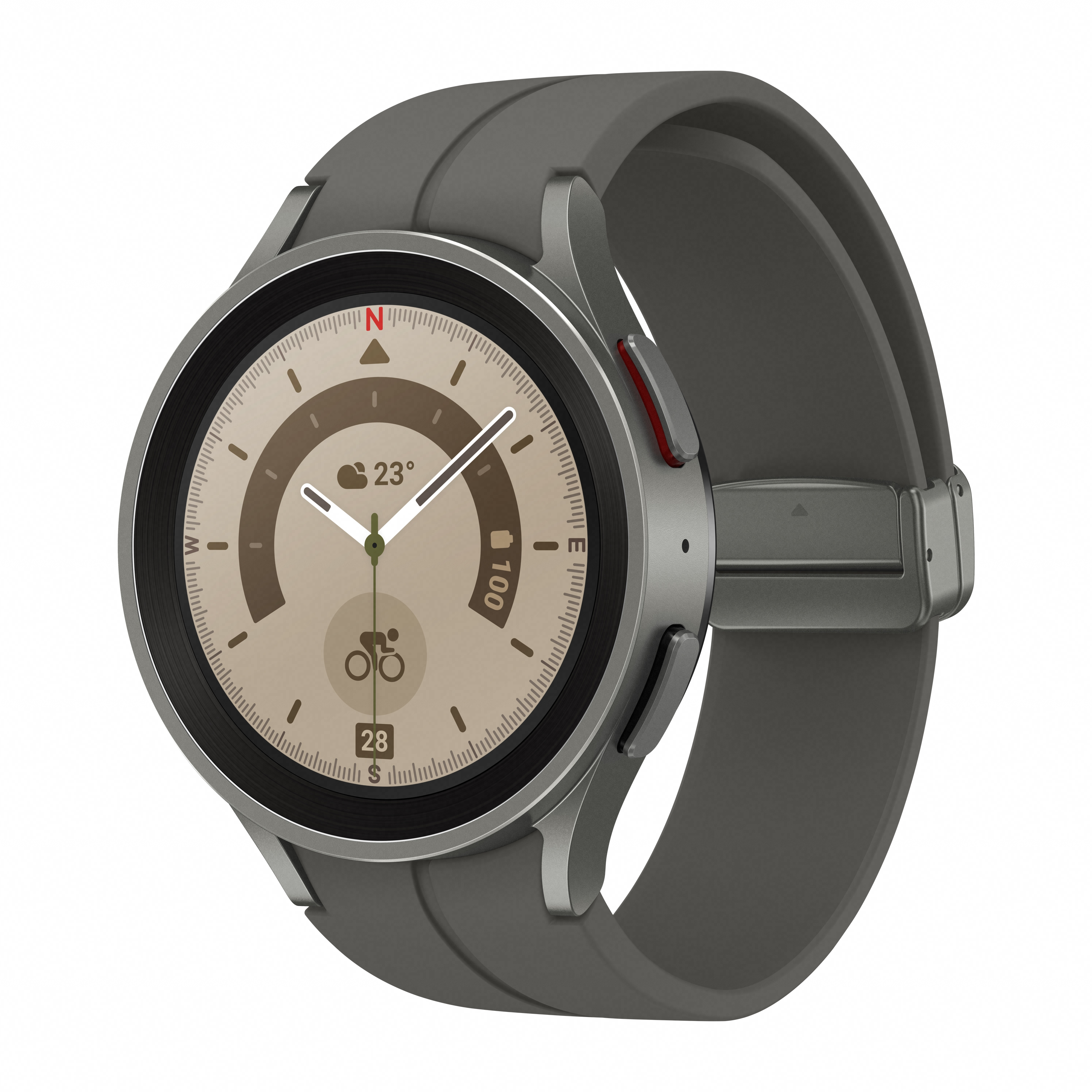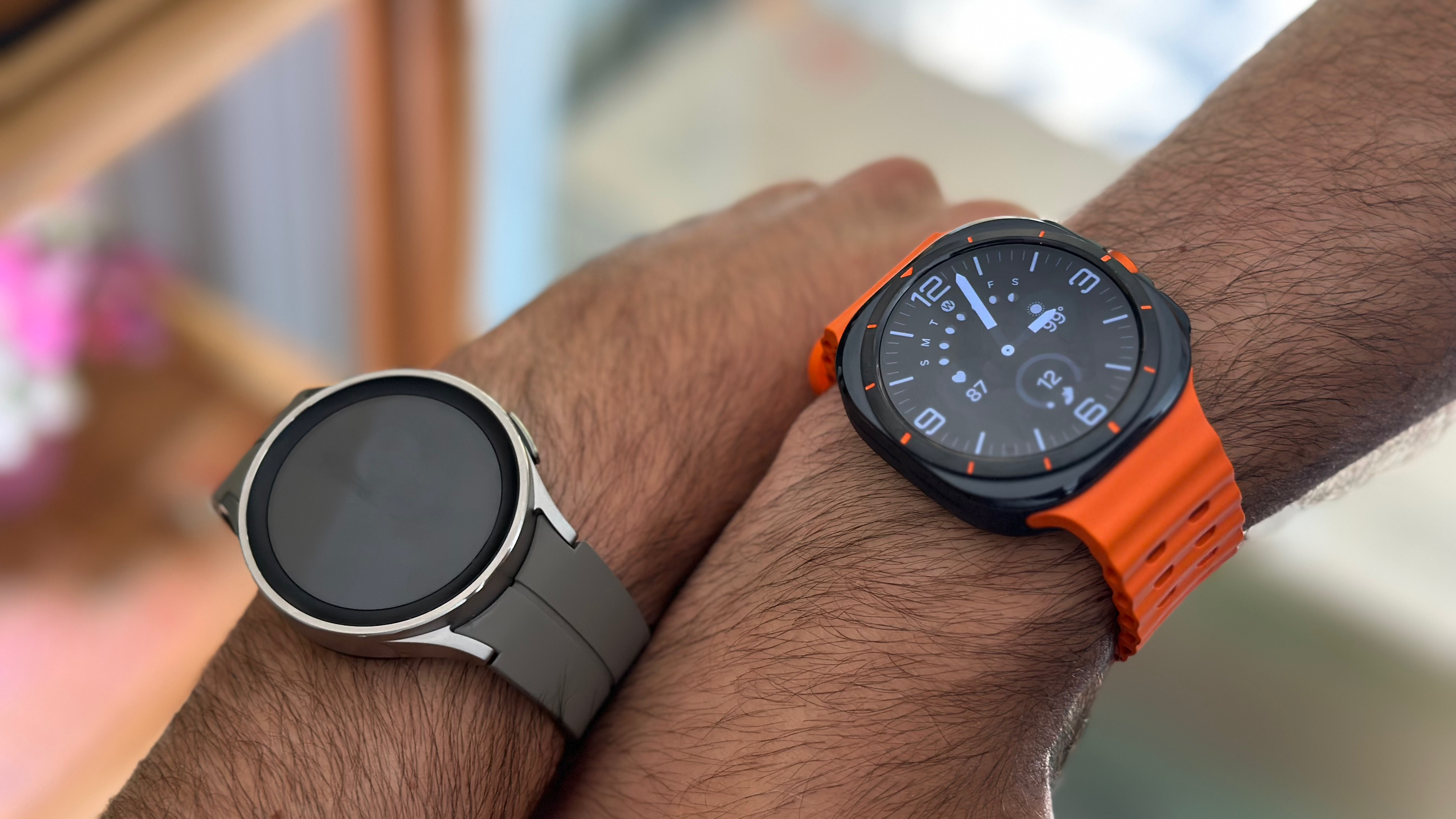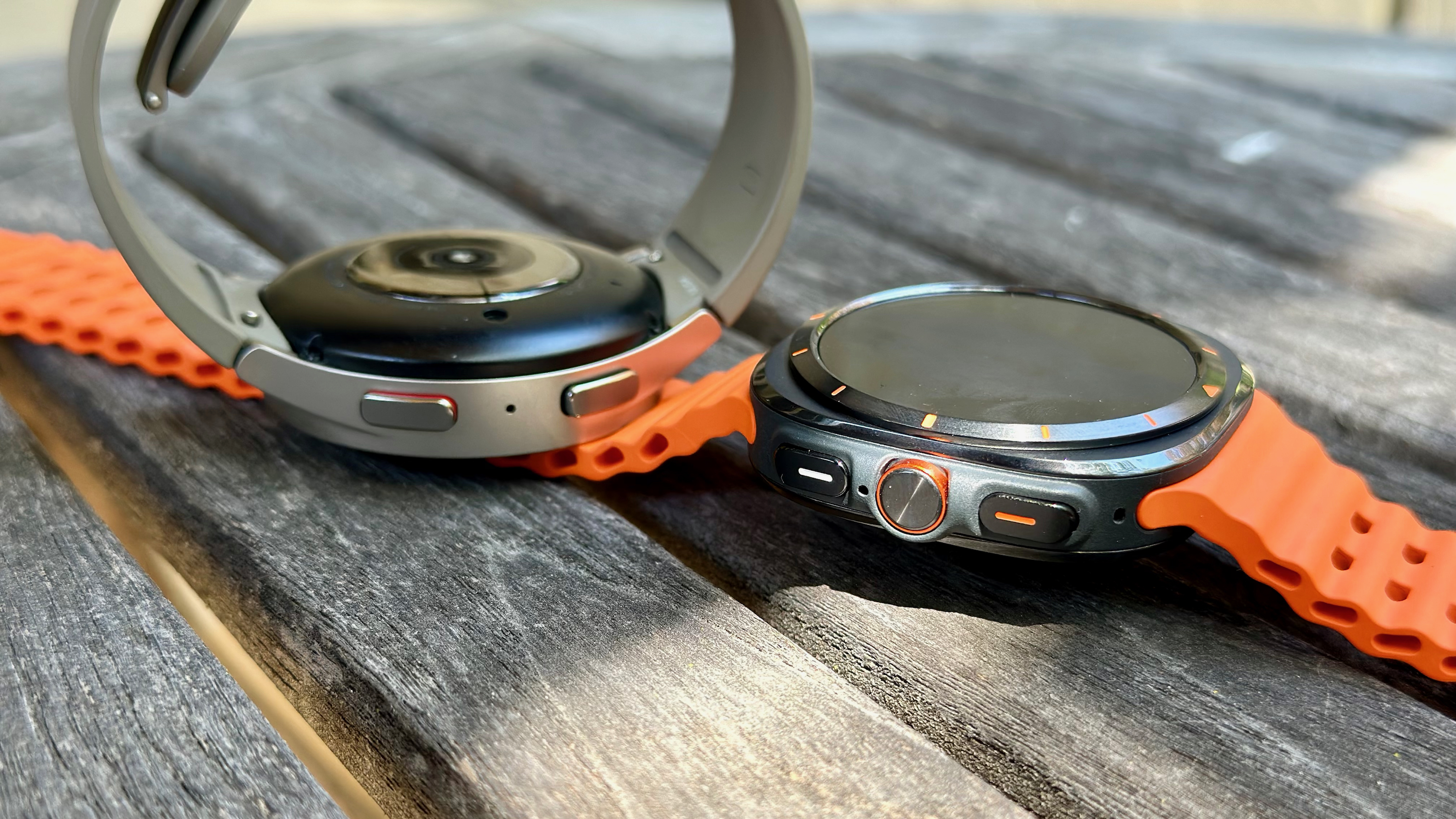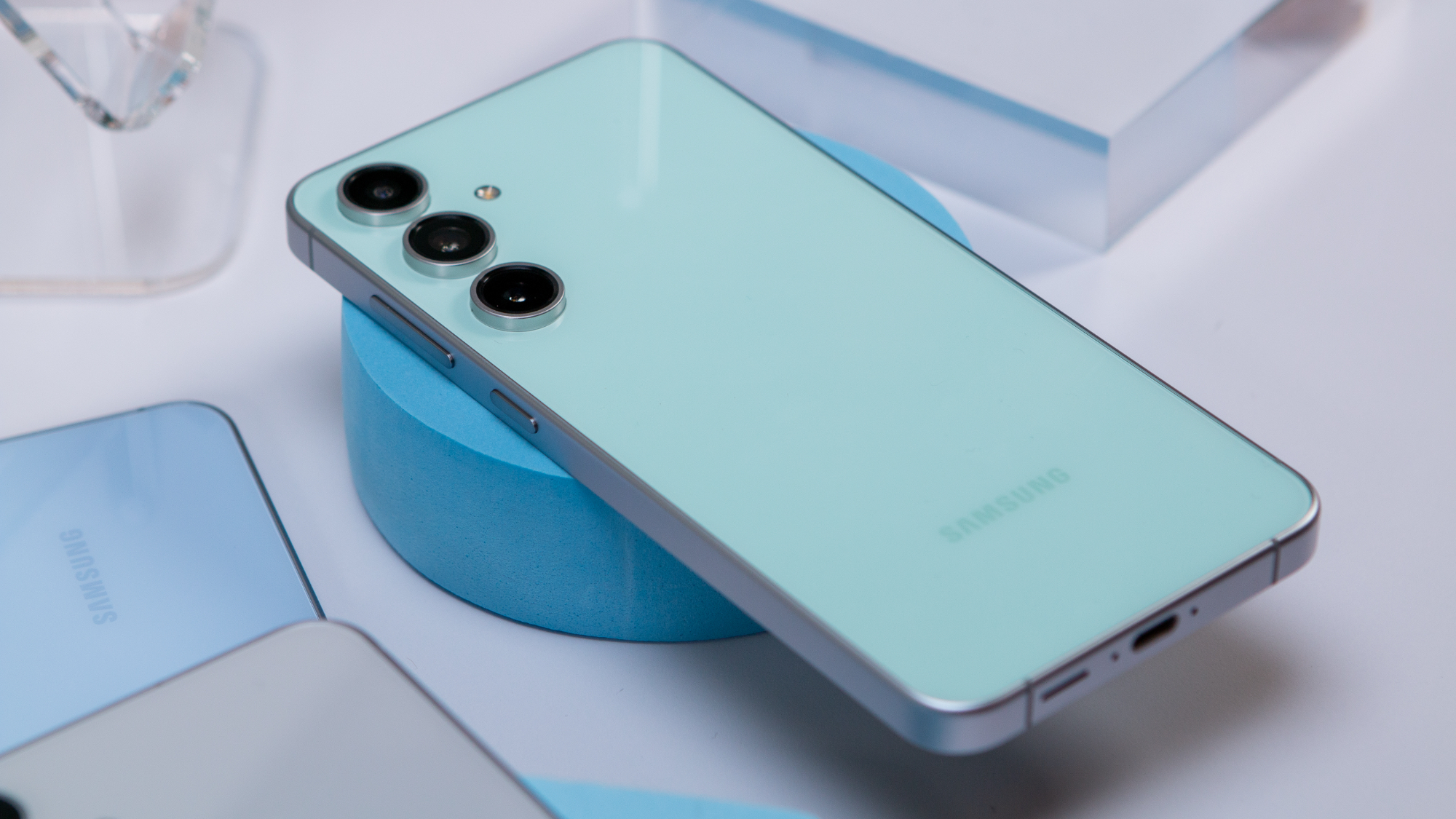Samsung Galaxy Watch Ultra vs. Watch 5 Pro: Should you upgrade?
Samsung gave the Watch Ultra and 5 Pro the same battery capacity, but they're very different in many other respects, such as performance, display, and sensors.

Faster, heavier, pricier
The Galaxy Watch Ultra has two generations of upgrades that make it an objectively better smartwatch than the Galaxy Watch 5 Pro. However, boosts to the CPU, display, health sensors, GPS, and other areas burn through the same 590mAh capacity faster, as well as making it thicker and weightier on your wrist. If you can accept these tradeoffs and the higher price, it's one of the year's best watches.
For
- Larger, ultra-bright display
- Faster performance and doubled storage
- Useful third button
- More accurate GPS and HR data
- Better battery life than Watch 7
- Three strap options, all better than Pro's D-Buckle Sport
Against
- Painfully pricey (without a trade-in deal)
- Heavy and thick
- Extra perks burn more battery

Still chugging along
The Galaxy Watch 5 Pro was one of the rare smartwatches that lasted days between charges. Since 2022, more smartwatches have hit this benchmark and added perks like dual-band GPS and brighter displays that make the Pro a bit outdated. Still, this trustworthy device has four years of software support left and is more comfortable than the Ultra (aside from the wonky band).
For
- Comparable (if not better) battery life
- Lighter and thinner
- Same health data, software, digital bezel
- Significantly cheaper, frequently discounted
- Still due for several Wear OS updates
Against
- Smaller, dimmer display
- Slower performance
- Polarizing default band
- Missing dual-band GPS / extra HR LEDs
Why weigh the Samsung Galaxy Watch Ultra vs. Watch 5 Pro, released two years apart? These two smartwatches are Samsung's only two designed with extended battery life in mind. Many Watch 5 Pro owners are weighing whether or not the upgrade is worth it.
As the person who reviewed the Galaxy Watch Ultra and Galaxy Watch 5 Pro, I'm ready to compare every perk the Ultra offers and the weaknesses that might make Pro owners decide to stick with their current watch for now. Samsung has told us it has no plans for new "Pro" watches, but that might change, and the Galaxy Watch Ultra is expensive.
Below, I break down every key similarity and difference between the Galaxy Watch Ultra and Galaxy Watch 5 Pro to help you decide!
Samsung Galaxy Watch Ultra vs. Watch 5 Pro: Design and display

Samsung made the Galaxy Watch Ultra and Watch 5 Pro available only in one size instead of the dual options with mainline Galaxy Watches. Of the two, the Pro has a more comfortable design, though not without its drawbacks.
The Galaxy Watch Ultra weighs 14g more and measures about 1.5mm thicker than the Galaxy Watch 5 Pro, a relatively large and heavy watch. Both use lightweight and durable titanium, but the Pro has a rounded case that matches its display bezel, while the Ultra has a square-shaped case jutting outside of the circular display at each corner — giving it a square look.
All recent Galaxy Watches have an IP68 rating against dust and water damage, and they can be submerged in fresh water up to 1.5 meters deep for up to 30 minutes. They also have a MIL-STD-810H rating against shock damage. The Galaxy Watch Ultra's protections go further: Samsung promises it can withstand altitudes as high as Mount Everest, temperatures from -4°F to 131°F (-20ºC to 55ºC), and deeper depths (10ATM) than the Watch 5 Pro (5ATM).

Samsung also gave both watches a raised bezel that helps prevent scratches if you bonk your watch against a wall. The Ultra bezel has lines matching a clock's hourly graduations, with different colors based on the case color. I like my Titanium Gray Ultra with orange lines, which match the orange Quick Button and my orange band. Compared to that, the Watch 5 Pro's appearance is more unadorned.
Speaking of bands, the Galaxy Watch Ultra has three default options: the thick elastomer Marine, rubber Peakform, and thin nylon Trail. The Galaxy Watch 5 Pro defaulted to the D-Buckle Sport, a magnetized band comfortable for everyday use but impossible to secure well during workouts. I disliked it and would have preferred any of the Watch Ultra's bands.
Both smartwatches have a Home and Back button along the right edge. In contrast, the Galaxy Watch Ultra has a third Quick Button for another shortcut. You can use the shortcut for pausing an exercise or activating a loud siren with a long press. Samsung didn't add a physical rotating bezel like the one found on the Galaxy Watch 6 Classic; instead, it uses a digital touch bezel along the display edge.

I'd start with the outdated display if you need a good reason to upgrade your Watch 5 Pro. A 1.4-inch AMOLED with 1,000 nits of brightness, the Watch 5 Pro display is perfectly readable indoors and has the exact 320 ppi resolution as the Ultra. But it's on the dim side in direct sunlight, and there is a lot of wasted black border space along the edge.
By contrast, the Galaxy Watch Ultra's 1.5-inch AMOLED hits a blazing 3,000 nits and looks fantastic every time I run in sunny weather. You won't find any wasted border space, but it does have one minor drawback. While using the digital bezel, your finger is more likely to block the bottom portion of the screen.
Samsung Galaxy Watch Ultra vs. Watch 5 Pro: Hardware and sensors
| Header Cell - Column 0 | Samsung Galaxy Watch Ultra | Samsung Galaxy Watch 5 Pro |
|---|---|---|
Display | 1.5-inch Super AMOLED, 480x480, 3,000 nits | 1.4-inch Super AMOLED, 450x450, 1,000 nits |
Colors | Titanium Sliver, Titanium Gray, Titanium White | Black Titanium, Gray Titanium |
Processor | Exynos W1000 (1.6GHz) | Exynos W920 (1.18GHz) |
RAM & storage | 2GB + 32GB | 1.5GB + 16GB |
Battery | 590mAh | 590mAh |
Software | One UI 6 Watch (Wear OS 5) | Wear OS 4 (Wear OS 5 soon) |
Sensors | Samsung BioActive Sensor (Optical Heart Rate + Electrical Heart Signal + Bioelectrical Impedance Analysis), Temperature Sensor, Accelerometer, Barometer, Gyro Sensor, Geomagnetic Sensor, Light Sensor | Samsung BioActive Sensor (Optical Heart Rate + Electrical Heart Signal + Bioelectrical Impedance Analysis), Temperature Sensor, Accelerometer, Barometer, Gyro Sensor, Geomagnetic Sensor, Light Sensor |
Dimensions | 47.1 x 47.4 x 12.1 mm | 45.4 x 45.4 x 10.5mm |
Weight | 60.5g | 46.5g |
Connectivity | LTE, Bluetooth 5.3, WiFi 2.4/5GHz, NFC, GPS (L1+L5), Glonass, Beidou, Galileo | LTE (optional), Bluetooth 5.2, Wi-Fi 2.4/5GHz, NFC, GPS/ GLONASS/ GALILEO/ Beidou |
Durability | 5ATM + IP68, MIL-STD-810H, Sapphire Glass | 5ATM + IP68, MIL-STD-810H, Sapphire Glass |
Price | $649 | $449 |
The Galaxy Watch Ultra has 33% more RAM, double the storage, and an Exynos CPU clocked significantly higher. Samsung claims the Exynos W1000 can load apps 2.7x faster and perform multi-core tasks 3.7x faster than the Exynos W930 in the Galaxy Watch 6. The Watch 5 Pro's Exynos W920 doesn't fall too far behind the W930 for clock speed. I have to say that less RAM does clearly affect daily use.
Before you get too excited about the 16GB of storage, you should know that Samsung uses around 11GB of it on the default Wear OS software. So if you want to stream music or podcasts on your smartwatch while leaving your phone at home, the Watch Ultra offers more storage to save downloaded playlists — or built-in LTE to stream things instead. With the Watch 5 Pro, you may or may not have spent the extra $50 for it.

With the Watch Ultra and the Watch 5 Pro, you get continuous heart rate and stress measurements. The smartwatch also allows you to track blood oxygen, breathing, skin temperature, and sleep stages, among other nightly stats. It also actively and passively checks for AFib issues. The Watch Ultra has newer Wear OS 5 health metrics like Energy Score, but we expect the Watch 5 Pro to receive that update later this summer.
One key difference is that Samsung gave the Galaxy Watch Ultra three LEDs along its bottom compared to older Galaxy Watches; this reportedly makes it more accurate for workout tracking, which proved noticeably true during my Galaxy Watch Ultra fitness test.
Another critical difference is that Samsung gave the Galaxy Watch Ultra dual-band GPS tracking, which remarkably enhanced the accuracy of my workout results compared to the GPS-only Watch 5 Pro or Watch 6. You'll appreciate this upgrade if you run, hike, cycle, or do any outdoor workouts in areas where tree foliage, buildings, or mountains can interfere with satellite signals.
Still, the Galaxy Watch 5 Pro is more comfortable while working out because of the weight, which may matter more if you choose the Pro as a fitness watch.
Samsung Galaxy Watch Ultra vs. Watch 5 Pro: Battery life, charging, and software
Samsung claims you can use the Galaxy Watch Ultra for 60 hours in normal conditions with AOD active, 16 hours during workouts with dual-band GPS, or 100 hours in power-saving mode. The Galaxy Watch 5 Pro's original estimate was 80 hours without AOD or 20 hours with GPS.
The Galaxy Watch Ultra has prevailed for closer to two days with AOD and maybe 12 hours while tracking workouts. The battery doesn't last as long since it has a much brighter screen, a faster processor with more RAM, and extra sensor LEDs. It's not far off from the Pro if you disable AOD, but it's not quite at the battery level you might hope for at this price point!
On the other hand, the Galaxy Watch 5 Pro is two years old, and my colleague Andrew Myrick—who continued to use the Watch 5 Pro for years—has told me its battery life has been cut in half since then. Thankfully, thanks to the 10W charging speed as the Ultra, you get a two-hour charging time frame on both smartwatches.
The other "longevity" point to consider is that the Galaxy Watch 5 Pro only gets software support through summer 2026, while the Galaxy Watch Ultra gets Samsung's usual four years of Wear OS upgrades. With this smartwatch, you get security patches through mid-2028.
Samsung Galaxy Watch Ultra vs. Watch 5 Pro: Should you upgrade?

A new Galaxy Watch 5 Pro is hard to find these days. When it's available, it's typically on sale, widening the $200 gap between it and the Ultra. Nevertheless, because of all the last-gen downgrades, I would say it's not worth buying new unless you can find one for really cheap.
What you think of your Galaxy Watch 5 Pro determines whether you should upgrade to the Galaxy Watch Ultra. Are you comfortable with the extra weight on your wrist, or is the slimmer Pro a perk worth holding onto? Do you require more storage, better health data, and faster app loading, or can you hold out for another year to save yourself some money?
You can downgrade to the shorter-lived Galaxy Watch 7 for something lighter, but for comparable battery life in a newer device, you'll need the Galaxy Watch Ultra. It's costly, especially once Samsung's limited-time $350 credit for the Watch 5 Pro ends, so if you are considering an upgrade, now would be the time!
Since its launch, the Galaxy Watch 5 Pro has been included on our list of the best Android smartwatches, but the Galaxy Watch Ultra is ready to claim that spot.

More of everything (the good and bad)
Choose the Galaxy Watch Ultra if you want all of Samsung's upgrades across the last two generations of wearables and can get a good trade-in deal for your Pro. Avoid the Ultra if you don't want the extra weight and like the Classic's physical bezel more.

Built to last in more ways than one
Stick with your Galaxy Watch 5 Pro if an Ultra upgrade is too expensive for your budget or bulky for your wrist, or buy one if you find it at a bargain price. The Pro is not a keeper if you're unhappy with the performance, display quality or health accuracy.
Be an expert in 5 minutes
Get the latest news from Android Central, your trusted companion in the world of Android

Michael is Android Central's resident expert on wearables and fitness. Before joining Android Central, he freelanced for years at Techradar, Wareable, Windows Central, and Digital Trends. Channeling his love of running, he established himself as an expert on fitness watches, testing and reviewing models from Garmin, Fitbit, Samsung, Apple, COROS, Polar, Amazfit, Suunto, and more.
You must confirm your public display name before commenting
Please logout and then login again, you will then be prompted to enter your display name.
